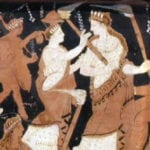 Creepy
Creepy  Creepy
Creepy  Space
Space 10 of the Weirdest Ways the Universe Works
 Weird Stuff
Weird Stuff 10 Crazy News Stories No One Expected to Read in 2025
 Crime
Crime 10 Bizarre Cases of Killer Seniors
 Technology
Technology 10 Signs That “Made in the U.S.A.” Still Lives
 Music
Music Top 10 Songs That Tell Stories Better Than Books
 Humans
Humans 10 Ways News Media Manipulate Readers
 Weird Stuff
Weird Stuff 10 Crazy-Specific Rules Dallas Cowboys Cheerleaders Must Follow
 Pop Culture
Pop Culture 10 Reasons We’ll Always Need Superman
 Our World
Our World 10 Ancient Places That Dropped Surprising New Finds
 Creepy
Creepy 10 Representations of Death from Myth, Legend, and Folktale
 Space
Space 10 of the Weirdest Ways the Universe Works
 Weird Stuff
Weird Stuff 10 Crazy News Stories No One Expected to Read in 2025
Who's Behind Listverse?

Jamie Frater
Head Editor
Jamie founded Listverse due to an insatiable desire to share fascinating, obscure, and bizarre facts. He has been a guest speaker on numerous national radio and television stations and is a five time published author.
More About Us Crime
Crime 10 Bizarre Cases of Killer Seniors
 Technology
Technology 10 Signs That “Made in the U.S.A.” Still Lives
 Music
Music Top 10 Songs That Tell Stories Better Than Books
 Humans
Humans 10 Ways News Media Manipulate Readers
 Weird Stuff
Weird Stuff 10 Crazy-Specific Rules Dallas Cowboys Cheerleaders Must Follow
 Pop Culture
Pop Culture 10 Reasons We’ll Always Need Superman
 Our World
Our World 10 Ancient Places That Dropped Surprising New Finds
10 Unsolved Mysteries From Ancient Times
Tourists travel to famous landmarks and spooky destinations every year, hoping for a deeper insight into mysterious structures and what happened within their perimeter thousands of years ago.
But sometimes, strange things happen to ordinary people in their own town. Finding out exactly what happened and why it happened remains of interest to millions around the world, especially when it seems that no logical explanation can be found.
10Salzburg Cube
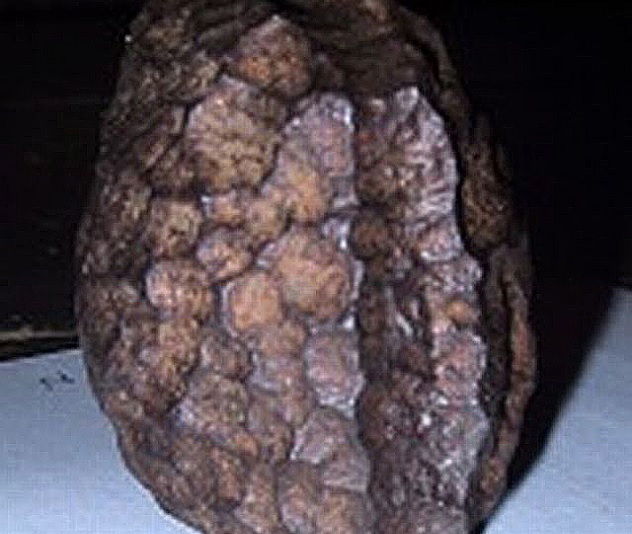
In 1885, Reidl, an employee at an Austrian foundry, discovered the mysterious Salzburg Cube (also known as the Wolfsegg Iron). He cracked open a seam of coal to find a strange-looking iron cube inside it. It had many cracks and little holes in it, as well as a strange color and a deep fissure down the middle. Reidl had never seen anything like it before, so after showing it to his boss, they turned it over to the Heimathaus Museum.
The next year, a professor at the museum named Adolf Gurlt studied the cube and determined it to be part of a meteorite. But further studies by the Natural History Museum in Vienna proved that it was not in fact a meteorite, but artificially manufactured from an unknown source. It is thought that the coal that “produced” the Salzburg Cube was at least 60 million years old.
Adding to the mystery of the Cube is how some people actually believe it to have vanished. The reasons for this range from it being part of a shadowy conspiracy to it simply being debunked as a worthless piece of rock and tossed away as such. This, of course ignores the fact that the Cube does in fact exist, and can be found safely on display at its usual home, the Heimathaus Museum in Vienna.
9Screaming Mummy
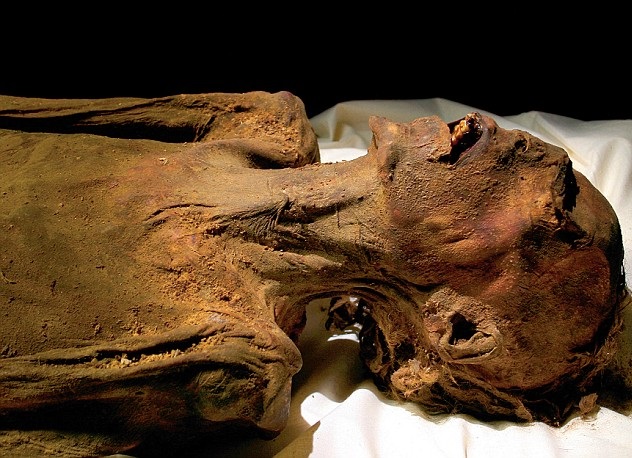
Discovered in 1886, a mummy with an agonized expression on his face has long since been the object of speculation. This mummy has all his organs intact, which is not customary with mummification. Many interesting theories have arisen, though none have been proven right or wrong.
Bob Brier, a University of Long Island archaeologist, speculated that two parties were responsible for the mummy’s agonized expression. One was the murderer, while the other ensured full preservation of the body (possibly due to a personal relationship with the victim). Other researchers and archaeologists have come up with theories ranging from cold-blooded murder to poisoning to being buried alive.
A 2008 National Geographic documentary special investigated the possibility that the mummy could be Prince Pentewere (son of Pharaoh Ramses III), who was suspected of planning his father’s murder. Ancient documents from the 12th century claimed one of Pharaoh Ramses III’s wives was tried for conspiring to kill him, due to her desire for Pentewere to take over the throne.
It is thought that when this plan was discovered, she poisoned Pentewere as punishment and rolled him up in sheepskin after being mummified. If that was the case, the “scream” could have been due to the pain from the poison ingested. However, only a CT scan had been done of the screaming mummy, and it remains pure speculation whether the mummy was in fact Prince Pentewere.
Less sensational theories suggest that the mummy’s jaw is open simply because his head most likely rolled back after death occurred. But even that bit of realism is as good a guess as anybody else’s.
8Ever-Burning Lamps
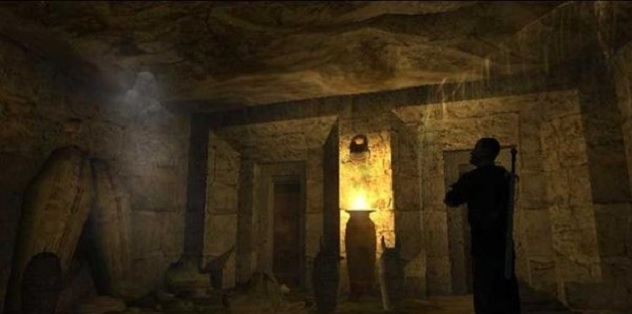
Lamps that kept on burning without using any fuel were discovered all over the world during the Middle Ages. These lamps were sealed into tombs, supposedly to ensure the deceased had light to guide them on their way to the afterlife. Some of these tombs were opened years later, and the lamps were still burning.
Superstitious types became terrified of this phenomenon, destroying any ever-burning lamp they came across. People accused pagan priests of trickery. Others simply refused to believe that a lamp could burn for an indefinite period of time. The vast majority claimed that the Devil was to blame.
Speculation was also rife that Hebrew communities had discovered and preserved what today is known as electricity. According to the legend, a French rabbi named Jechiele possessed a lamp that could light up by itself, with no fuel or wick. Jechiele, according to this tale, invented a special button that would discharge an electric current to his metal door knocker. If someone touched the door knocker at the same time the rabbi touched the nail, the person would receive a shock and double over.
Even with electricity being a common thing nowadays, all who have tried to replicate the ever-burning lamps have failed. Therefore the question remains: How were these lamps able to keep burning for hundreds of years without fuel?
7Panxian Caves
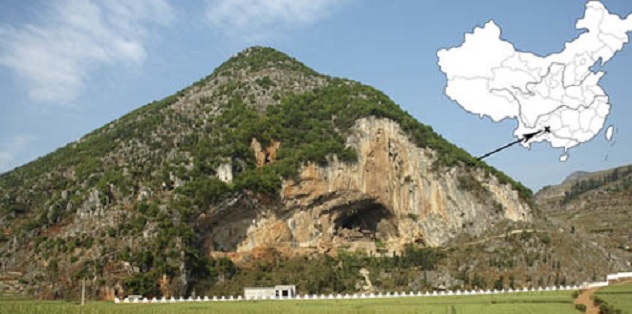
The Panxian Dadong Caves are known to have housed humans 300,000 years ago. It is also known that large animals inhabited the vicinity of the caves as well. Scientists, however, were extremely surprised to find prehistoric deposits indicating massive stegodons and rhinoceros also lived, or at least died, inside the caves. They found this very strange, seeing as how the caves are 1,600 meters (5,250 ft) above sea level.
Paleoanthropologist Lynne Schepartz stated how rare is is to find animals in a cave that don’t typically live in them. She believed that stegodons and rhinos were very unlikely to simply wander into the cave. Rhinos, in particular, are solitary animals that graze on their own. And yet, here lie their remains.
One theory involves carnivorous animals killing the mammals and dragging them into the cave. The most likely answer, though, would be human intervention. Inspection of the bones showed that they were burnt and then pounded by what could only have been a tool made out of stone.
The last expedition to the cave took place in 1998. To date, no further progress has been made in determining just exactly how those large animals got into the cave at all.
6Lady Of The Spiked Throne
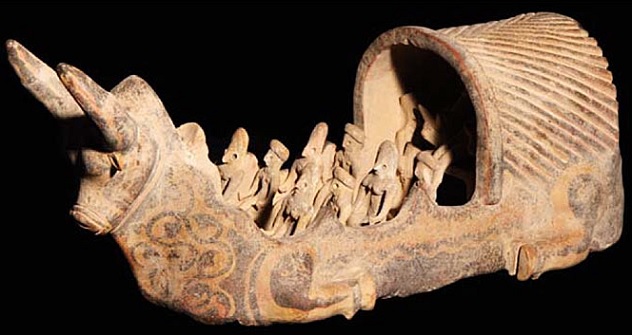
The Lady of the Spiked Throne is the fitting name given to a mysterious and unique artifact dating back to 2700 B.C. The artifact remains one of the strangest ancient objects ever found.
After ensuring that it was not a fake, Italian archaeologist Massimo Vidale and his team noted the Lady’s unique look for posterity. The object is shaped like a large vehicle—most likely a chariot or boat—ending at the front with the figurine of a large bull’s head. Inside the vehicle are 15 figures forming what can be described as a procession. There are traces of yellow, red, and black on these figures.
Some of the male figurines share the same adornments around the neck and on their head. Conical gowns are “worn” that have not been observed in other similar figurines. You can also see a female figurine can be seen seated on a “throne of spikes,” therefore the name Lady of the Spiked Throne.
Vidale’s studies concluded the Lady was created by the ancient Indus civilization, but its meaning and purpose is a mystery. No evidence suggests Indus used any four-wheel vehicles, and it is unknown whether the artifact was made for ritual use or another, more practical reason.
5Ancient Structure Underneath Sea Of Galilee
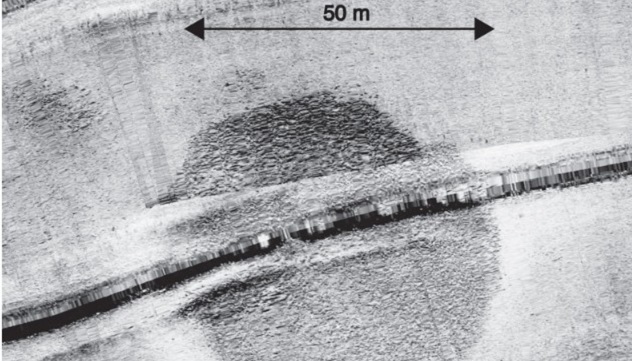
In 2003, scientists accidentally discovered a circular structure underneath the Sea of Galilee. Publishing the findings almost 10 years later, geophysicist Shmuel Marco told CNN that they were very surprised to see what looked like a Bronze Age statue on the ocean floor. Marco speculated that the ancient structure may have been a marine nursery. Most archaeologists, however, believe it was situated on land and became submerged by the water over time.
The structure is made up of basalt and shaped like a cone. Measuring 70 meters (230 ft) at the bottom, the structure is 10 meters (33 ft) tall, and is estimated to weigh 54.5 million kilograms (60,000 tons). It can be compared to the size of two Stonehenges. Its age is estimated to be between 2,000-12,000 years old, a range determined by calculating the amount of sand that accumulated over the base of the structure, as well as comparing it to similar structures.
Archaeologist Dani Nadel has interestingly noted that the structure has similar features to that of other ancient burial sites in the area. Calling it a truly unusual find, Nadel theorized that the structure could have been used for ceremonial purposes. He also pointed out how the structure being built using large stones weighing almost 100 kilograms (220 lb) each was a very impressive feat. He stressed, however, that the true purpose and age of the structure will likely remain unknown.
4Hidden Shoes In Egyptian Temple

Archaeologists discovered an unusual “treasure” during an expedition in Egypt in 2004. In a jar, placed in the middle of two other jars and set into a small open space between two mud-brick walls, were seven shoes. Two of the pairs were children’s shoes, and the remaining shoes belonged to an adult that possibly had a limp. Archaeologist Angelo Sesana stated that this “shoe jar” had been hidden deliberately more than 2,000 years ago.
Andre Veldmeijer, an expert in ancient footwear, has called the discovery of the shoes “extraordinary” because of the excellent condition they were found in. He analyzed the shoes and theorized that they were quite expensive and meant for status. He added that there’s mystery surrounding the hiding of the shoes and how the owners never retrieved them. Veldmeijer speculated that there may have been some form of unrest in the area, causing someone to hide their shoes for reasons unknown and flee the scene.
3Baiae Tunnels

More than 2,000 years ago, the Baiae temple in Rome was a popular destination, known alternately for minerals with supposed immortality-bestowing powers, and possibly housing the entrance to Hades. Now, just the mysterious ruins remain.
In the 1960s, Robert Paget and Keith Jones decided to explore these ruins. After struggling to get through the narrow opening, they found themselves in a narrow tunnel and smelled volcanic gas. Paget found the start of the tunnel complex was pointed toward the summer sunrise, and the tunnels ran perfectly from east to west toward the equinoctial sunrise. This indicated rituals were a factor during the building of the tunnels.
The pair found many niches meant for lamps along the tunnels and indications that great thought went into the building and setting out of the tunnels in order to keep them hidden. They also found what seemed to be a ventilation system inside a blockage within the tunnel system.
However, it was when they reached the end of a steep tunnel that the real mystery presented itself. Just after a sharp bend ran a stream of boiling hot water. A stone landing projected out into the water and seemed to vanish into the dark. The men decided that if Hades did in fact exist, they had just found its mythical entrance.
In 1965, the two men, with the help of Colonel David Lewis, determined the boiling water was due to underground volcanic chambers that produced hot springs. However, even with that new knowledge, they still could not solve the mystery of who built the tunnels of Baiae, or what their real purpose was.
2Antelope Springs Footprint
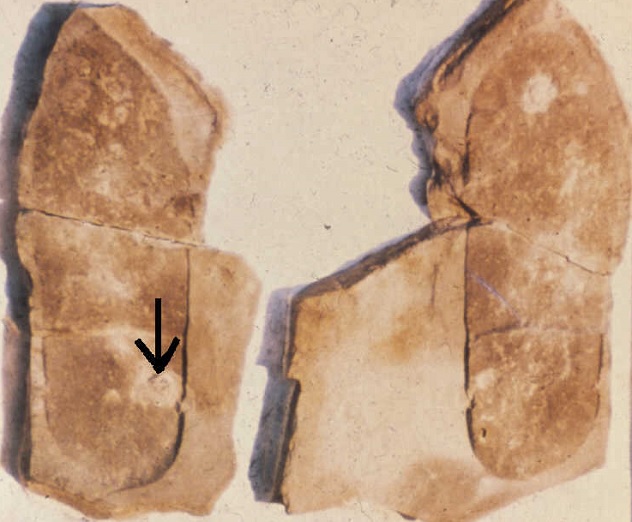
On June 1, 1968, amateur fossil hunter William J. Meister Sr. took his family on a trip to Antelope Springs. Meister couldn’t take off his fossil-hunting jacket, though, and went in search of trilobite fossils. He eventually found a fossil with what looked like a shoe imprint, the heel digging in deeper than the rest of the foot. Below the imprint, he found two trilobite fossils. Meister immediately thought that the person wearing the shoes had stepped onto the fossils.
Taking it for examination, Meister and fellow researchers dated the fossil at almost 600 million years old and determined it was likely formed in Middle Cambrian Wheeler Shale. When they explored the area, they discovered slabs of mudstone that had, once upon a time, formed an entire land area.
The mystery, however, is that while the shoe print clearly indicates someone standing or stepping on the trilobites, there is no evidence indicating any pressure on the trilobites themselves. Also, the trilobites were marine creatures, meaning that whoever created the shoe print had entered their area. Why exactly, nobody knows.
1The Pyramid Of Hellinikon

It seems strange to think that there are pyramids in Europe, but there are quite a few of them. In Greece alone there are 16 pyramids, of which the most well-known is the Hellinikon pyramid in Argos.
First mention of the pyramid was made in the writings of ancient Greek geographer Pausanias. In Description of Greece, he describes the structure as “a building made very like a pyramid, and on it in relief are wrought shields of the Argive shape.” He then mentions a battle that took place at the pyramid and the reconciliation that took place afterward. A “common tomb” was built here for those that fell during the battle.
Not much is known known about the pyramid other than its estimated date of construction, which was first thought to be 3000 B.C., but was changed in the ’90s to 2720 B.C. (with an error margin of 720 years). If this date is correct, then the Hellinikon pyramid might well be older than even the oldest Egyptian pyramid.
But the greatest mystery about this pyramid isn’t its age—it’s that no one knows who built it or what it was actually used for. The biggest mystery seems to be that all excavation efforts have been abandoned, despite the significance that the structure may hold in understanding ancient history.
Estelle lives in Johannesburg, Gauteng. She loves all things mysterious.
